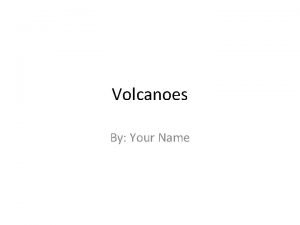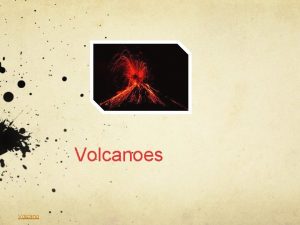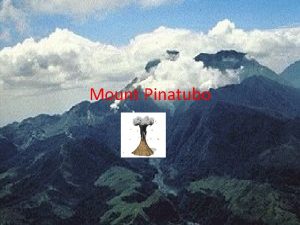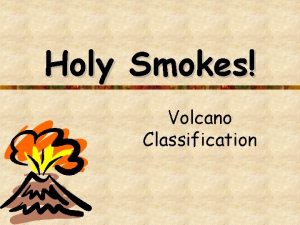Volcano Name Mount Mazama Classification Series of overlapping






- Slides: 6

Volcano Name: Mount Mazama Classification: Series of overlapping shield and stratovolcanoes Formation: North-South trending active fault movement related to subduction of the Juan de Fuca and Groda plates beneath the North American Plate. History/Description: Mount Mazama is part of the Cascade Range in southern Oregon, near Medford. About 420, 000 years ago, Mount Mazama began erupting continuously as a complex of shield and stratovolcanoes. The caldera at Mount Mazama’s summit (which today we call Crater Lake) was created 7, 000 years ago in the largest explosive eruption in the Cascade Range in the last 1 million years. Scientists use submersibles and sonar to study Image above: artistic rendition of Mt. Mazama the volcanic products that are beneath theerupting. Image below: Volcanic Hazard Zones of Mt. Mazama surface of the lake. https: //volcanoes. usgs. gov/volcanoes/crater_lake/geo_hi st_mazama. html Volcano Name: Newberry Volcano Classification: Shield volcano Formation: Subduction of the Juan de Fuca and Gorda tectonic plates under the continental North American tectonic plate History/Description: The Newberry Volcano is the largest volcano in the Cascades Volcanic Arc, covering 1, 200 square miles (about the size of Rhode Island) and is active today. This shield volcano has erupted repeatedly over the past 400, 000 years, but about 75, 000 years ago, the Newberry volcano had an explosive eruption that collapsed the summit and created two caldera (which today, host two lakes). The last eruption occurred about Image above: ago aerial view of the two caldera of the Newberry Volcano 1, 300 years and present-day hot springs Image below: Diagram of subductive action, forming the Cascades Volcanic Arc and geologically young lava flows indicate https: //www. fs. usda. gov/recarea/deschutes/recarea/? recid=66159; that it is still an active volcano. https: //volcanoes. usgs. gov/volcanoes/newberry/monitoring_earthquakes. html

Volcano Name: Three Sisters Classification: Shield (North Sister), cone (Middle Sister), stratovolcano (South Sister) Formation: Subduction of the Juan de Fuca and Gorda tectonic plates under the continental North American tectonic plate History/Description: North Sister is the oldest of the three sisters and is composed of older eruptive product and is considered extinct. Middle Sister is the smallest and has not been wellstudied. Middle Sister lost its east side Image: The Three Sisters labeled. due to glacial erosion. This Sister is considered extinct. South Sister is the https: //www. volcanocafe. org/the-volcanoesyoungest (50, 000 years old) and tallest of-the-three-sisters-area-oregon/ https: //volcanoes. usgs. gov/volcanoes/three_ of the three. South Sister las erupted sisters/geo_hist_south_sister. html 2, 000 years ago, at which time a small caldera at the summit was formed, creating the highest lake in Oregon. Each of the Three Sisters formed at different times. Name: by different. Mount types of Rainier Volcano magma. Classification: Stratovolcano Formation: Subduction of the Juan de Fuca plate off the western coast of North America. History/Description: Mount Rainier is considered to be active and is the highest peak in the Cascade Range (14, 410 ft). About 500, 000 years ago, Mount Rainier began to grow on top of the remains of an ancestral volcano. Since the last ice age, several dozen explosive eruptions spread tephra (ash and pumice) across parts of Washington. The last magma eruption was 1, 000 years ago. About 40 million years ago, much of what is now western Washington lay beneath the sea, and widespread volcanism began due to the process of subduction off the margin of North America. Scientist collect realtime seismic and deformation (changes to the Image top: Seismic monitoring station on Mt. Rainie surface of the volcano that occur due to magma movement under the surface) measurements. Image bottom: Mt. Rainier https: //volcanoes. usgs. gov/volcanoes/mount_rainie

Volcano Name: Mount Hood Classification: Stratovolcano Formation: Subduction of the Juan de Fuca plate off the western coast of North America. History/Description: Mount Hood is Oregon’s highest peak and has erupted periodically for about 500, 000 years. During recent eruptive periods within the last 1, 500 years, growing lava domes high on the southwest side of the mountain have collapsed repeatedly. In the early 1800’s the Lewis and Clark Expedition documented descriptions of the valley below Mount Hood, giving historians insight into changes in volcanic deposit in the Image top: Mount Hood and Lost Lake valley rivers over time. A recent risk Image bottom: Road damage caused by lahars in assessment study of Mount Hood and 1980 https: //volcanoes. usgs. gov/volcanoes/mount_ho showed that new lahars (mudflow or debris od/ down the slopes of a volcano) could cause billions of dollars in damage to propertyhttps: //en. wikipedia. org/wiki/File: Hood 85_mount_ and affect the lives of thousands of hood_and_lost_lake_ca 1985. jpg residents. Volcano Name: Mount Saint Helens Classification: Stratovolcano Formation: Subduction of the Juan de Fuca plate off the western coast of North America. History/Description: Mount Saint Helens, located in Washington State, is the most active volcano in the Cascade Range. Before the 1980 eruption, Mt. St. Helens had a conical shape. At the time of the 1980 eruption, the upper 1, 300 ft of the summit was removed by a huge avalanche, leaving a horseshoe-shaped caldera now partially filled by a lava dome and glacier. It is primarily an explosive volcano with a complex magma system. Mount St. Helens was formed during four eruptive stages beginning about 275, 000 years ago. Scientists have been monitoring subtle inflations of the ground surface and minor earthquake activity in recent years. Careful analysis of these two lines of evidence now gives us Image top: Map of Mt. St. Helens with annotation of pre-1980 topography. Image bottom: Location of magma formation, accumulation and storage beneath Mt. St. Helens https: //volcanoes. usgs. gov/volcanoes/st_helens/

Volcano Name: Axial Seamount Classification: Submarine Volcano (Seamount) Formation: Created by the intersection of a “hot-spot” with a mid-ocean ridge. As tectonic plates move over the “hot-spot” a chain of volcanoes is produced in order of oldest to youngest. The Hawaiian Islands, the Galapagos Islands, and the Cobb. Eikelberg chain that includes Axial volcano are all examples of hot spot chains. History/Description: The Axial Seamount is located about 300 miles off the coast of Oregon about 1 mile below the surface. It is the most active submarine volcano in the Pacific North West. It is the site of the first under water research station called the Cabled Axial Seamount Array, which allows researchers to data stream and track Image top: The location of Axial Seamount off of the coast of Oregon. https: //www. pmel. noaa. gov/eoi/axial_site. html underwater eruptions and seismic activity to Image Bottom: The Cabled Axial Array for real time observations. http: //oceanobservatories. org/array/cabled-axial-s researchers on land. Volcano Name: Kilauea Classification: Shield Formation: Similar to the Axial Seamount, the Hawaiian Islands were formed by the pacific plate moving over a “hot-spot. ” It has been active for the past 2, 500 years. Eruption: “Scientists infer that the eruption style is determined by the amount of magma being supplied to the volcano. When magma supply is high, the summit caldera fills and feeds voluminous lava flows from summit and rift zone vents. When the magma supply drops, the caldera collapses. When the caldera floor is deep enough to be at or near the water table (about 500 m (1640 ft) deeper than present), water can seep into the vent to trigger steam explosions. ” (USGS. Gov) History/Description: Kilauea is the youngest volcano on the Island of Hawai’i and is one of the world’s most active volcanoes. Kīlauea is the home of the volcano goddess named Pele. According Image top: “At Kilauea, when the lava column drops below that water table, groundwater may come into contact with magma causing violent steam explosions” (USGS. gov) Image bottom: Kilauea volcano, Hawai’i https: //volcanoes. usgs.

Hot-Spot Volcanoes The Hot-Spot Hypothesis: In 1963, J. Tuzo Wilson, a Canadian geophysicist as “The Hot-Spot Hypothesis. ” This hypothesis was able to explain how island chains, such as the Hawaiian. Emperor chain, appear in a straight line, with only small bends as the plate moves. How deep are hot spots? The actual depth of these hot-spots is unknown and researchers are actively trying to answer that question. This process is integral in creating new islands and land as it rises up from the seafloor. Forming Volcanoes: A hot-spot is an area under the Earth’s crust that receives a high amount of magma from the mantle. The high heat is deep source of magma and it is fixed to one place, meaning it does not move. As the tectonic plate(s) above the hot-spot move, volcanoes and, even islands, form. While most volcanos and earthquakes occur at tectonic plate boundaries, Hot-Spot Volcanoes can occur near a boundary (like the Axial Seamount and Green land) or below a plate (like the Yellowstone Geyser, Hawaii, or the Galapagos), but what makes a hot-spot volcano is that the volcanoes Image: Hot-Spot Hypothesis appear. The in a. Hawaiian straight line. https: //geology. com/usgs/hawaiian-hot-spot/ Why study Volcanoes? Goals: Many people (scientists, geologists, engineers, naturalist, hobbyists, etc. ) study volcanoes. The idea is that if we study them, we can better understand how they form, predict how destructive a future eruption might be, and use that information to prepare for emergency situations On Land Under the Ocean: The volcanoes found on land under the ocean are studied in very similar ways. On land, tilt (slope) and strainmeters (shape) measure small changes in the shape of the volcano as it inflates with magma. Under the ocean, scientist use remote operated vehicles to position tilt (slope) and pressure meters (rise or fall of the seafloor) to also measure the slope and shape of the volcano. Using these instruments, scientists can tell if the volcano is inflating with magma, and even predict when it Image top: Tiltmeter being lowered into a 10 ft. deep hole might erupt on Mauna Loa'snext. Southwest Rift Zone, Hawaii. https: //volcanoes. usgs. gov/vhp/tilt_strain. html Image Bottom: A bottom pressure-tilt instrument installed at the summit of Axial Seamount. http: //oceanobservatories. org/instrument-class/botpt/

What Happens at Tectonic Plate Boundaries? Volcanoes and Earth Quakes: Generally all volcanoes and earthquakes occur near plate boundaries, except for areas near hot-spot volcanos. The Tectonic plates sit on the Earth’s crust in the lithosphere, and as they move and run into each other they form divergent (plates moving away from each other), convergent (plates moving together with one going on top of the other), and transform (plates sliding past each other) plate boundaries causing earthquakes and creating volcanos. Big Booms: Earthquakes release pressure that has built up where the two plates meet over time, and how strong there are depends on the type of rocks, plate, and pressure that has built up there. For Volcanos, the size of the eruption is related to how much water has seeped under the lithosphere at the plate boundary, and then as that is heated by the magma is melts the rock around it and create a nasty volatile mixture of rock and super hot water. As this mixture heats up, it rises up melting more rock, and then erupts as lava! Depending on the type of rock and how much water seeped in, determines the size of the eruption. Image : A generalized diagram showing the lithospheric situation associated with the formation of convergent, divergent, and transform plate boundaries. Illustration prepared by the United States Geological Survey. https: //geology. com/platetectonics. shtml The Ring of Fire Where is it? The Ring of Fire is in the Pacific Ocean. It is a horse shoe shaped regions formed by several tectonic plates interacting with the norther, western, and eastern edges of the Pacific Plate. As these plates interact, they form volcanos and cause earthquakes. What is happening there? In the Ring of Fire you can find 452 volcanos, which is 75% of the world’s active and dormant volcanos. Also, about 90% of the world’s earthquakes occur in the Ring of Fire accounting for 81% of the world’s largest and strongest earthquakes. What areas does the Ring of Fire effect? The Ring of Fire responsible for some of the volcanos and earthquakes found in Bolivia, Chile Ecuador, Peru, Costa Rica, Guatemala, Mexico, Image top: States, Tectonic. Canada, Plates and Active Volcanoes of the United Russia, Japan, World: Most active volcanoes are located along or near the Philippines, Indonesia, New Zealand, boundaries of Earth's shifting tectonic plates. Only and some of the Earth's more than 500 active volcanoes are shown here Antarctica. (red triangles). https: //volcanoes. usgs. gov/vhp/tilt_strain. html Image Bottom: Map showing the geographic location of major ocean trenches in the Pacific Ocean.











